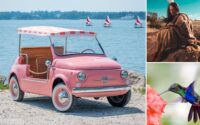Go bald eagle birding while cruising the Connecticut River
The bald eagles are twitterpated and RiverQuest, a birder-focused cruise, is weighing anchor.
The two-decade-old cruise run by the Connecticut River Museum — which documents New England’s longest river’s ecology and history, and houses a replica of Dutch Colonist and fur trader Adriaen Block’s ship, the Onrust — departs from Haddam, about 12 miles upriver from Essex.
Naturalist Cathy Malin, a 10-year RiverQuest veteran, leads the sightseeing cruises, which take in the whole riverscape, from wildlife to geology, and from ecology to history.
The special birding cruises run through late fall and culminate in the otherworldly spectacle of the swarming tree swallows.
“Every cruise is different because the river is different with each season, and the scenery changes every day,” Malin told The Post, adding that in March, when it’s colder, “we usually have the whole river to ourselves.”
Less boats equals less humans, less disturbance — and better chances of wildlife roaming close to the banks and eagles flying.
The bald eagle was designated the United States’ national bird in 1782, but by the 20th century, they were on the brink of extinction. They were added to the endangered species list in 1978.


No longer listed as endangered, Malin estimates there are now about eight nesting couples in this area, up from zero in the mid-20th century.
These comeback kids signify the Connecticut River’s return to good health.
“There are local eagles who live here year round and visiting eagles who are just here to get some fish,” said Malin. “But there are more resident eagles nesting than ever before.” That’s a sign fish populations are rebounding.
RiverQuest’s Winter Wildlife Eagle Cruises begin as the eagles start a new cycle of raising their young.
“Most eagles lay eggs in mid to late February; it takes 34 to 36 days for the eggs to hatch,” said Malin, who lives in nearby Old Saybrook. “There is one couple on the river who lay in March. When a nest has a couple whose lay date changes, it can be an indication there is a new mate.”

A popular saying among wildlife biologists is that eagles mate for life and mourn for a minute.
“Once a partner dies, they soon pair up with a new mate,” added Malin.
While the eagles are loved-up and cozied-up incubating their eggs, Malin advised cruisers wrap-up well: “Wear layers, because the best views are out on deck, not from the cabin,” she said.
Afterwards, warm up at The Gris. A few minutes walk from the museum’s dock, the Griswold Inn, opened in 1776, has the largest private marine art collection in America scattered throughout its lobby, restaurant and bar, where its fun sea shanty live music nights have returned after the COVID break. (Rooms from $160 per night.)
RiverQuest Winter Eagle Cruises cost $45 per person, which includes complimentary museum admission, and depart at 10 a.m. and 12:30 p.m., Friday to Sunday, March 4 through March 20 from the Connecticut River Museum at 67 Main St., Essex, Conn.


